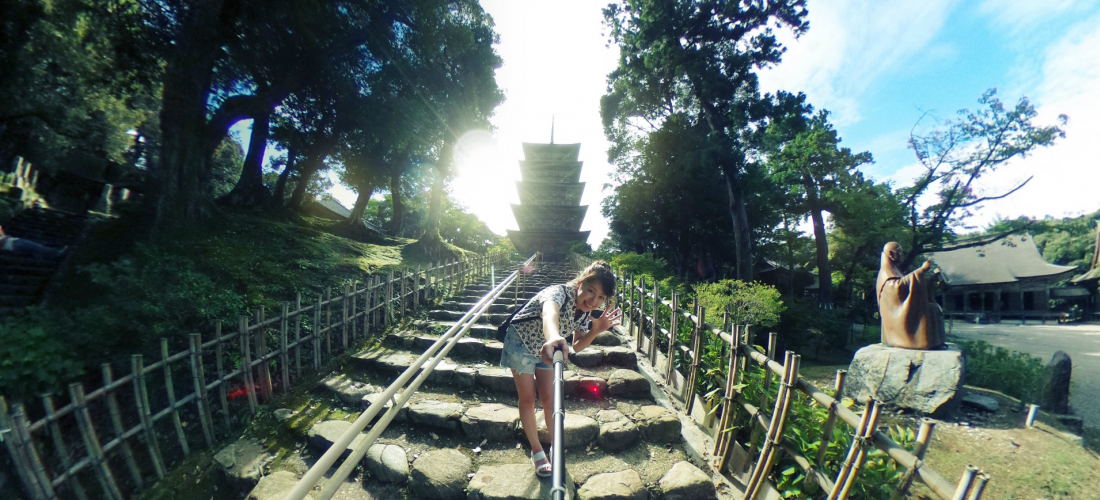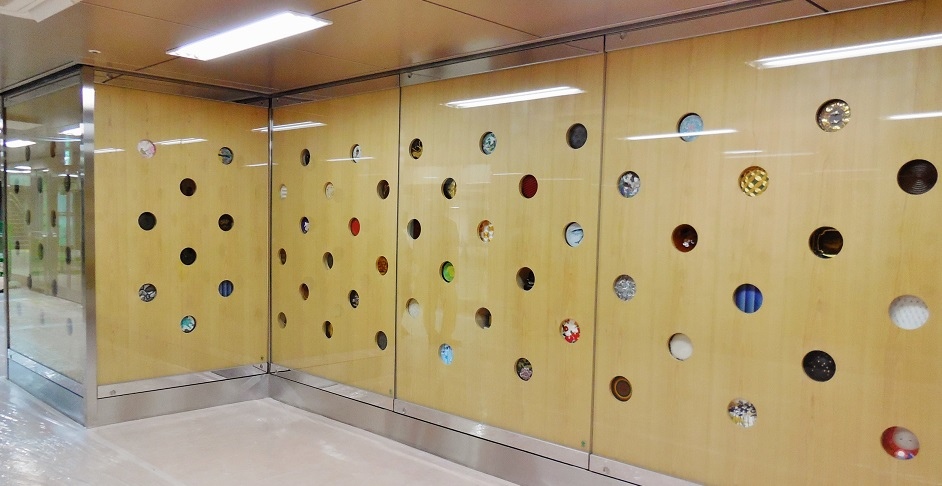
CONTENTS
JOUR ② : Partons Découvrir Kanazawa et ses Alentours
Nous vous racontions dans notre précédent article le premier jour de notre périple à Kanazawa, nous voici de retour pour le Jour ②. Si vous avez rater le début de notre voyage nous vous invitons à lire cet ARTICLE dans un premier temps! Il y a de nombreux spots et paysages à découvrir dans la ville et ses alentours : rues traditionnelles, salons de thé, etc. Si vous vous rappelez nous évoquions le fait que la ville était reconnue pour l’importance de son artisanat, laissez-nous vous présenter cet aspect de la ville.
・Temple Myōjō (妙成寺 Myōjō-ji)
・Marché Ohmi-chō (近江町市場 Ohmi-chō shijou)
・Station de Kanazawa (金沢駅)
・Musée d’Art Contemporain du 21ème siècle de Kanazawa (21世紀美術館)
・Akadama (赤玉)
・Fin de notre voyage
Ce temple a été bâti en 1294 et vous y trouverez 10 biens culturels du pays. On dit aussi que le temple porterait chance à ceux qui viendrait y prier! C’est également l’une des architectures caractéristiques de l’Epoque Edo ayant résistée aux différents tremblements de terre frappant le Japon!
Temple Myōjō
Takidani-machi, Hakui-shi, Préfecture d’Ishikawa

de Novembre à Mars 8h – 16h30



Page Web (Anglais)
Des épiceries aux vendeurs de poissons frais, de fruits et même de viandes vous trouverez tout ce dont vous avez besoin pour préparer des bons petits plats. Des restaurants proposent même de déjeuner sur place et de goûter aux produits frais du marché.
3 Bonnes raisons de s’y rendre :
① Imprégnez-vous de l’atmosphère des marchés locaux japonais
Vous souhaitiez vous mettre à la place des locaux pour un petit moment? C’est ce que vous offre ce marché et c’est toujours une expérience fantastique!
② Accès aisé pour les voyageurs
Du marché Ohmi-chō vous pouvez vous rendre en seulement 15 petites minutes de marche au Jardin Kenroku, à Higashiyama et même au Musée d’Art Contemporain de Kanazawa.
③ Goûtez aux produits frais
Il y a un bon nombre de restaurants répartis à travers les allées du marché. Vous trouverez forcément un endroit à votre goût : sushi, ‘Korokke’ (コロッケ; purée de pommes de terre en friture), etc. N’oubliez pas de jetez un oeil aux heures d’ouverture des boutiques que vous souhaitez visiter!
Marché Ohmi-chō
50 Kamiomicho, Kanazawa, Préfecture d’Ishikawa


Page Web (Japonais)
Notre Recommandation : Morimori Sushi, vos sushis sur un Shinkansen
Parmi les restaurants que vous trouverez au Marché Ohmi-chō, nous vous conseillons vraiment de faire un saut à restaurant de sushis, non seulement pour son côté ludique mais aussi pour la fraîcheur du poisson. En effet vos sushis vous seront livrés par un petit Shinkansen, toujours apprécié des enfants! (Attention cette option est seulement disponible à l’espace ‘table’・N’oubliez pas non plus de presser le bouton rouge pour renvoyer le wagon!)
Tous les poissons et fruits de mer sont pêchés dans la Péninsule Nanden, fraîcheur garantie! Nous pouvons d’ailleurs vous aiguiller sur le choix des poissons, notre recommandation : la perche de mer (のどぐろ), reconnu comme le poisson roi de Kanazawa. Ce poisson est plutôt rare à trouver dans le Kantō alors ne ratez pas cette occasion d’y goûter.
Morimori Sushi Ohmi-chō (もりもり寿司近江町店)
Ichiba-kan, Ohmicho, Kanazawa, Préfecture d’Ishikawa



Page Web (Japonais)
Station de Kanazawa, l’une des plus belles gares au Monde!
Choisie par le magazine américain, Travel & Leisure, la station de Kanazawa a été classée comme l’une des plus belles gares. Vous n’avez pas d’autres choix que d’y passer et de prendre quelques photos avant de rentrer!
Station de Kanazawa
1-1 Kinoshinbo-machi, Préfecture d’Ishikawa

Page Web (Japonais)
❶ Tsuzumimon
A la sortie Est de la station vous trouverez ce magnifique portail en bois créé à l’effigie des tambours japonais (鼓門, Tsuzumimon).
❷ Dôme Motenashi
3019 pièces de verre ont été utiles lors de la conception de ce dôme couvrant l’entrée de la station. Son nom, ‘Motenashi’ (もてなし) transmet la “Bienvenue à tous les visiteurs de Kanazawa”.
❸ Des touches d’art et d’artisanat partout
Vous trouverez des touches décoratives évoquant l’artisanat traditionnel de la Préfecture d’Ishikawa un peu partout dans la gare, même jusque sur le quai!
❹ Le meilleur lieu pour une séance de shopping
La station est également un lieu propice au shopping. Vous y trouverez un bon nombres de boutiques et de restaurants. Pourquoi ne pas en profiter pour ramener quelques souvenirs à vos proches?
A seulement une quinzaine de minutes de voiture de la station vous atterrirez au Musée d’Art Contemporain. Le musée est un bon moyen de saisir l’empreinte de l’histoire de l’artisanat traditionnel de la ville sur l’art dans son ensemble.
Musée d’Art Contemporain du 21ème siècle de Kanazawa
1-2-1 Hirosaka, Kanazawa, Préfecture d’Ishikawa

Zone ouverte au public 9h – 22h (20h les vendredis et samedis)
*Fermé tous les lundis



Page Web (Anglais)
Nous avons été étonné de trouver des Oden (おでん, type de pot-au-feu) dans la plupart des ‘Izakaya’ (居酒屋, bistrot japonais) de Kanazawa. Akadama n’est pas un simple izakaya! Le restaurant propose des odes depuis son ouverture en 1927. Cette recette proche de notre pot-au-feu est appréciée en hiver, quoi de mieux que de se réchauffer autours d’un bon plat chaud.
Akadama Oden
2-21-2 Katamachi, Kanazawa, Préfecture d’Ishikawa

2F 17h – 23h30 (fermeture à 22h30 les dimanches et jours fériés)


Page Web (Japonais)
Kanazawa, la Ville Dorée
Notre voyage à travers la préfecture d’Ishikawa touche déjà à sa fin. La ville dorée, Kanazawa a vraiment été une très belle découverte pour nous! Nous espérons que ces deux articles vous auront donné quelques idées de lieux à visiter sur place!
Restez connectés pour de nouveaux articles originaux tous les jours sur JAPANKURU
N'hésitez pas à nous suivre également sur nos réseaux Facebook et Instagram pour plus d'histoires japonaises!
















 >> Find out more at Japankuru.com! (link in bio)
#
>> Find out more at Japankuru.com! (link in bio)
#





 The Robot Restaurant is gone, but the Samurai Restaurant is here to take its place. Check it out, and don't forget your coupon!
The Robot Restaurant is gone, but the Samurai Restaurant is here to take its place. Check it out, and don't forget your coupon!
 신주쿠의 명소 로봇 레스토랑이 사무라이 레스토랑으로 부활! 절찬 쿠폰 발급중
신주쿠의 명소 로봇 레스토랑이 사무라이 레스토랑으로 부활! 절찬 쿠폰 발급중
 18歲以上才能入場的歌舞秀,和你想的不一樣!拿好優惠券去看看~
#tokyo #shinjuku #samurairestaurant #robotrestaurant #tokyotrip #도쿄여행 #신주쿠 #사무라이레스토랑 #이색체험 #할인이벤트 #歌舞伎町 #東京景點 #武士餐廳 #日本表演 #日本文化體驗 #japankuru #japantrip #japantravel #japanlovers #japan_of_insta
18歲以上才能入場的歌舞秀,和你想的不一樣!拿好優惠券去看看~
#tokyo #shinjuku #samurairestaurant #robotrestaurant #tokyotrip #도쿄여행 #신주쿠 #사무라이레스토랑 #이색체험 #할인이벤트 #歌舞伎町 #東京景點 #武士餐廳 #日本表演 #日本文化體驗 #japankuru #japantrip #japantravel #japanlovers #japan_of_insta
 코지마 x 빅 카메라 쿠폰으로 일본 가전 제품 쇼핑하기
#pr #japankuru #japanshopping #kojima #biccamera #japaneseskincare #yaman #dji #osmopocket3 #skincaredevice #日本購物 #美容儀 #相機 #雅萌 #日本家電 #일본여행 #면세 #여행꿀팁 #일본쇼핑리스트 #쿠폰 #일본쇼핑 #일본브랜드 #할인 #코지마 #빅카메라 #japankurucoupon
코지마 x 빅 카메라 쿠폰으로 일본 가전 제품 쇼핑하기
#pr #japankuru #japanshopping #kojima #biccamera #japaneseskincare #yaman #dji #osmopocket3 #skincaredevice #日本購物 #美容儀 #相機 #雅萌 #日本家電 #일본여행 #면세 #여행꿀팁 #일본쇼핑리스트 #쿠폰 #일본쇼핑 #일본브랜드 #할인 #코지마 #빅카메라 #japankurucoupon











































